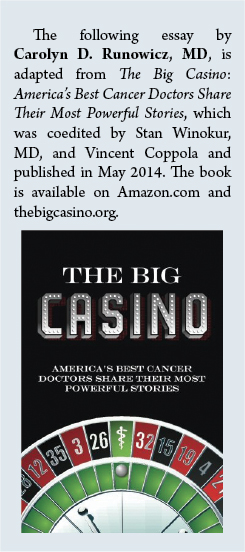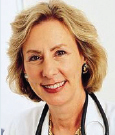The following essay by Carolyn D. Runowicz, MD, is adapted from The Big Casino: America’s Best Cancer Doctors Share Their Most Powerful Stories, which was coedited by Stan Winokur, MD, and Vincent Coppola and published in May 2014. The book is available on Amazon.com and thebigcasino.org.
Just imagine a world without cancer!
I encountered my first patient with advanced ovarian cancer during the summer before my second year of medical school. It was the early 1970s. I remember her sitting in a chair, her legs swollen and her abdomen distended with fluid; she was unable to eat. She died a few days later. I was astounded that a disease could be so virulent. This woman never knew the profound impact her disease had on me. She influenced my career choice and commitment to care for women with gynecologic cancers.
As a first-year medical student, I’d been awarded an American Cancer Society student fellowship to shadow an oncologist. That’s how I met Dr. George C. Lewis, Jr, and Dr. Jim Lee, my first mentors. They radiated an excitement and enthusiasm for their specialty—gynecologic oncology—that was infectious and inspirational. They loved being physicians and were never too busy to teach and have me tag along on hospital rounds, the operating room, or the office. I wanted to be just like them.
Later, as a resident at Mount Sinai Hospital in New York, I joined the Department of Obstetrics and Gynecology led by Dr. Saul Gusberg, a founding father of gynecologic oncology. Larger than life, Saul was President of the American Cancer Society, a nationally and internationally renowned oncologist. Yet he was always available and never too busy [to talk with me]. We became lifelong colleagues. When he died, at the memorial service, his son stated that I was the daughter that Dr. Gusberg never had. I was so proud.
Progress in Cancer Treatment
As a resident, I worked under researchers designing and participating in clinical trials using a new drug, cisplatin. It would prove incredibly effective in the treatment of ovarian cancer, but it was also terribly toxic. One of my responsibilities was to persuade (at times, cajole) patients to be admitted for treatment. At the time, we did not have the arsenal of antinausea agents and other supportive therapies that we have today. I recall some patients stating they would rather die than be treated with these toxic drugs.
Vividly remembering that patient from my first summer in medical school, I was sure that cisplatin toxicity was better than the torment she suffered before she died. Eventually, all the patients agreed to be admitted. I had a growing appreciation and admiration for these strong women. I still shudder when I think of what they went through. The chemotherapy now available for ovarian cancer patients and the antinausea and supportive therapies have eradicated this horrible experience.
After my fellowship, I continued on at Mount Sinai for a couple of years as a faculty member, and then I was recruited to Albert Einstein College of Medicine and Montefiore Medical Center to develop a division of gynecologic oncology and a fellowship program. Training fellows and watching them become leaders in the field are enormously rewarding experiences.
Underserved Population
In the Bronx, where Einstein is located, patients are very different from those in Manhattan. Generally speaking, they are underserved and consequently present with much more advanced disease. I recall a 35-year-old patient with advanced cervical cancer that had spread to her lungs. I’d never encountered such advanced gynecologic cancer in a newly diagnosed patient. Such extensive disease is uncommon in the United States. Working in the Bronx was like being in a Third World country.
I reviewed her medical records and realized that she had been told of an “abnormal” Pap smear at the birth of her youngest child 7 years earlier. I asked her why she had not accessed the Einstein/Montefiore health-care system, which was right in her backyard. She said her priority was taking care of her seven children—providing food, clothing, and shelter. How many times had she visited the pediatrician and emergency room for her children? Yet, she didn’t have time for herself.
At her deathbed, she was surrounded by her children. The oldest was 17 years old and pregnant. I realized that these children would not likely escape the same vicious cycle of poverty. I envisioned this teenager in 10 years with seven children, neglecting her own health care, just as her mother had done. Ironically, she told me she was having a girl and would name the baby after her mother.
Surviving Breast Cancer
At Einstein/Montefiore, we were able to establish a successful clinical program and fellowship. Just when I thought my life couldn’t be better, I was diagnosed with breast cancer. I was 41. I was not only an oncologist but also a cancer patient. Because the disease had spread to my lymph nodes, I was treated with chemotherapy, radiation, and tamoxifen. My treatments went from July until the following Memorial Day, a grueling 11 months.
Antinausea therapy and supportive treatments were not yet available. I lost weight and truly looked like a concentration camp victim. (My family and friends consistently told me how good I looked.) I thought I was an empathetic and caring physician before I was diagnosed with cancer, but now I had lived through it all. I developed even more respect for my patients and truly understood that those of us who survive feel like survivors. We have won a personal battle against cancer.
Cancer as a Chronic Disease
With my cancer behind me, my next big career challenge was moving to the University of Connecticut School of Medicine to rebuild its cancer program into a multidisciplinary, comprehensive cancer center. During this time, there were many advances in ovarian cancer. Patients began living with the “chronic” disease of ovarian cancer—living for years on chemotherapy. I remember one patient who was diagnosed with ovarian cancer at the time of her cesarean section. This patient is still alive with the disease, intermittently on chemotherapy—and her “baby” is now getting ready for college.
Over my career, I have seen progress in ovarian cancer but few long-term cures. The cure is elusive, but we work on understanding the disease and developing more effective therapies. My first patient with ovarian cancer would most likely have lived a very different life if she had been diagnosed today.
My journey as a patient was not yet over. One weekend night, I found myself short of breath, wheezing, and coughing. I was sure I had very bad bronchitis and just needed antibiotics. I went to the emergency room and again entered the world of the patient. A nurse took my pulse and vital signs and immediately moved me to a monitored bed. Everyone around me looked much too serious—not at all what I had anticipated for bronchitis.
Finally, the radiologist, a friend of mine, came to my bed and said my chest x-ray looked bad. My first thoughts were that my cancer had recurred and that I had lung metastases. He said, “No, it’s worse.”
What is worse than recurrent breast cancer? Then I learned that I had a cardiomyopathy and was in congestive heart failure. The medical team admitted me to the cardiac unit and began treatment that night. I spent the next 2 weeks in that unit.
I went home; it was the middle of a cold and snowy winter. I was not able to return to work for nearly 4 months while the medications worked on restoring my cardiac function. I was lucky: it came back to almost normal. I take my eight pills a day. I’m back to working and taking care of patients. Taking care of my patients was very important for me to feel that I was truly recovered.
Looking Toward a Bright Future
About this same time, I was offered a new and challenging position as an associate dean in a new medical school. My doctors gave me the medical clearance, and I was off to warmer climes and new challenges.
Although my new position is mostly administrative, it is important for me to see patients at least part-time. I enjoy taking care of them as they embark on their cancer journey. I hope to lighten their burdens.
Training the next generation of physicians is exciting and rewarding. They are excited about the future that awaits them. Once again, I think back to my summer in medical school and the ovarian cancer patient I met. What lies ahead for these students is likely to be far more exciting, with technologic advances beyond our imagination. My hope is that one day, we will think of cancer like we do polio—a historical footnote in medicine.
Just imagine a world without cancer! ■



